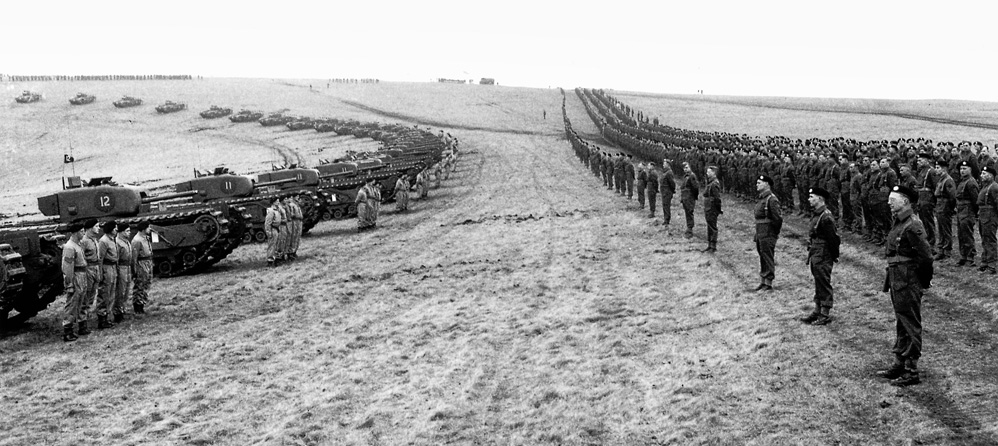In late January 1943 the 1st Canadian Army Tank Brigade was informed that an important inspection was coming up. The person conducting the inspection was not immediately revealed, but it was obviously someone of considerable prominence, based on the level of effort being expended. It was soon announced that the visitor was none other than King George VI and the inspection was scheduled for 11 February.
The 1st Canadian Army Tank Brigade was located in the south of England at this time, with the units of the Brigade spread through various communities in the county of West Sussex. The inspection took place east of the town of Brighton in a natural amphitheatre topped by a hill known as “The Bostle”, located here on Google Maps: https://goo.gl/maps/X6ifZZLRbtJocyzL9.
The Ontarios were tasked with providing the Churchill tanks for the day. In early February the crews began washing and painting each vehicle. On 10 February the tanks were driven from the Regiment’s headquarters at Seaford to the inspection area where they were parked in a horseshoe arrangement, each vehicle precisely positioned, following the contour of the hill. The Regiment returned to Seaford by truck late that afternoon.
A truck convoy brought the Regiment back to the inspection site, arriving at 0830 hours of 11 February. A rehearsal of the inspection was conducted, the soldiers had lunch and they waited for the appointed hour. Great precautions were taken to ensure the King’s safety. Anti-aircraft guns were positioned around the perimeter and P-51 Mustang fighter planes flew overhead.

It was a full day of military visits for the King. He inspected 7 Canadian Anti-Tank Regiment in the morning, several support units of 1 Canadian Corps at noon and then ate lunch at the Headquarters of 1 Canadian Corps.

King George VI rides in a Loyd carrier with the senior members of the inspection party. The King is on the right side of the vehicle and is wearing a light coloured coat and forage cap. The tanks immediately behind are from 12 troop, “C” Squadron of the Ontario Regiment.
The King and his party arrived at The Bostle at 1445 hours and climbed aboard a Loyd Carrier, crewed by three members of the Ontario Regiment – Sergeant George Bastien (Timmins, ON), Trooper Tom Osborne (Toronto, ON) and Trooper Frank Cunningham (Nashville, TN). The carrier was followed by nine jeeps with the remainder of the inspection party. This mini convoy drove past the formation of 55 Churchill tanks of the Ontario Regiment. Each tank crew was standing in front of their tank. Other members of the Ontarios were formed up on the outside of the tank formation. The Calgary Regiment, Three Rivers Regiment and the various support units of the Brigade were also on parade, but dismounted.

The senior members of the inspection party consisted of:
- Vincent Massey (High Commissioner for Canada)
- General A.G.L. McNaughton (commander of 1st Canadian Army)
- Major-General P.J. Montague (Senior Officer, Canadian Military Headquarters)
- Major-General J.H. Roberts (acting commander of the 2nd Canadian Division)
- Major-General F.F. Worthington (commander of the 4th Canadian Armoured Division)
- Lieutenant-General E.W. Sansom (commander of II Canadian Corps)
- Lieutenant-General K. Stuart (Chief of the Canadian General Staff)
- Brigadier R.A. Wyman (commander of the 1st Canadian Army Tank Brigade)
- Brigadier A.E. Walford, 1st Canadian Corps
- Brigadier E.C. Plow
The King dismounted from the carrier at the saluting base where he was received by Brigadier Wyman. The King received the Royal Salute from the assembled formation and then began his walking inspection of the dismounted troops. Next, the King remounted the carrier which drove along the line of tanks to conduct the inspection of the Ontario Regiment’s vehicles and their crews. Ontario Regiment commanding officer Lieutenant-Colonel M.P. Johnston joined the King for this segment. Finally, the carrier took the King back to the saluting base for the completion of the inspection. The Ontarios conducted a roll-past of the tanks, dipping their guns in salute to the King.
At one point during the day, the King inquired of Lieutenant-Colonel Johnston why the tanks of Headquarters Squadron were all named after race horses. Johnston replied that the crews had made money on those horses. King George VI noted, “I have a rather good horse myself.” The horse that he was referring to was “Sun Chariot,” which had won the Fillies Triple Crown series of races as well as other prominent races in the UK. With the permission of King George VI the CO’s tank was renamed “Sun Chariot.” This name was resurrected briefly in the 1980s as the name of the monument tank at the Colonel R.S. McLaughlin Armoury in Oshawa.
At the completion of the inspection the King had tea at the 1st Canadian Army Tank Brigade Officers’ Mess and left for London at 1630 hours.
And a final note…Trooper Cunningham, the soldier from Tennessee, was quoted in several American newspapers as saying the King was “good guy” and “he speaks very good English.” Yes, the King of England speaks very good English.
Rod Henderson
Rod Henderson is the Regimental Historian of the Ontario Regiment. He served as a Sergeant in the Regiment and is the author of “Fidelis Et Paratus: The History of The Ontario Regiment RCAC”.


